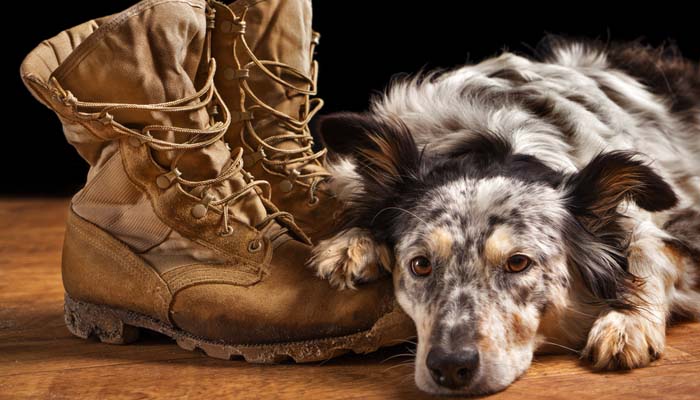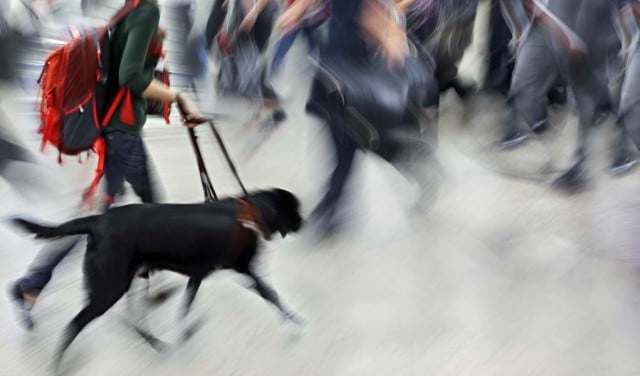
Table of Contents
Pet owners can often be heard exclaiming, “I couldn’t live without my dog.” Indeed, many of us could not imagine life without our animals. However, for some, a canine companion may truly be a matter of life and death – that's why having the proper service dog gear is so important for the dog's handler.
The history of dog-kind helping mankind is a long one. The first school designed specifically for training dogs to aid the impaired was started in Germany during the first World War. This school utilized dogs to aid blind soldiers recovering from their injuries on the battlegrounds.
Since then, the scope of service dogs has been expanded to include aiding those with a range of physical impairments as well as those who face psychological and emotional challenges.
There is a wide range of service dog gear available for handlers as well. Depending on the job that the dog is performing, a handler may need just a few items or he could need a whole list of supplies.
RELATED: How to Get a Service Dog for Anxiety or Depression
Service Dog Gear Must-Haves
What's The Most Important for Owners?
The general public most often identifies service dogs by their brightly-colored vests or jackets. The Americans with Disabilities Act (ADA) – which dictates the provisions for service dogs – does not require that working dogs wear identification of any kind.
Nonetheless, the human partners of these dogs frequently find it helpful to indicate to passersby that their dog is working. This way, respectful people will know not to distract the dogs from their duties.
Although it might be tempting to pet a service animal, when the dog is on duty, it shouldn’t be called to, touched, or approached unless its owner has invited such interaction. Service dogs have working schedules and recreation time, just like people do, and most people don’t enjoy being pestered by random folks while they’re on the job.
RELATED: Therapy Dog Training – How To Get Your Dog Certified
Vests
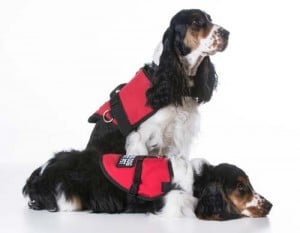 Bright orange or yellow vests worn by service animals often include “do not touch” warnings as a reminder to keep your distance. The bright vests also help shop owners and employees identify service dogs.
Bright orange or yellow vests worn by service animals often include “do not touch” warnings as a reminder to keep your distance. The bright vests also help shop owners and employees identify service dogs.
This way, they don’t have to ask the owner about the dog. The ADA regulations are very strict about what a store owner can and cannot ask the service dog owner.
For example, he or she cannot ask what the nature of the handler’s disability is or ask them to provide a doctor’s note. If the service dog is wearing a vest, then store operators will be able to more easily avoid potential violations of the Act.
RELATED: Why Dog Parents Need to Invest in Dog Vests
Dog Harnesses
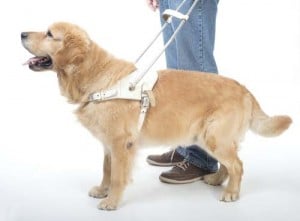 Another frequently-utilized piece of service dog gear is the harness. There are several types of harnesses, but most are fashioned from leather or imitation leather with metal clasps, buckles, and rings. The rings can be used to attach leashes, gentle leads, or bridge handles.
Another frequently-utilized piece of service dog gear is the harness. There are several types of harnesses, but most are fashioned from leather or imitation leather with metal clasps, buckles, and rings. The rings can be used to attach leashes, gentle leads, or bridge handles.
The harness serves much the same purpose as a collar does. However, since service dogs are on duty much of the time, the harness provides a more comfortable way to handle the dog. It serves to redistribute pressure across the dog’s body so that the equipment isn’t wearing too much in one spot.
Bridge handles, which clip onto the harness, are usually made of stiff material and hold their inverted U shape. This piece of equipment enables the dog’s handler to keep the dog closer to his or her body.
Having the dog closer not only helps the handler get physical cues from the dog, but keeps the dog in work mode. The bridge handle can also serve to provide support to those who have mobility issues.
CHECK THIS: The Best Dog Harness
Service Dog Gear for Police and Military K-9's
Some service dogs aren’t trained to assist their handlers with medical conditions, but serve in a different way. Police dogs, or K-9 units, are trained to be used in combat situations. This practice – much like how seeing-eye dogs got their start – began during times of war.
For centuries, dogs have accompanied men and horses into battle. Not only are dogs swift, agile, and quiet, they’ve got an intimidating set of weapons right in their mouths.
Using these attributes, as well as the dog’s general desire to please, people have trained service dogs to protect their handlers. They can also sniff out things like drugs and explosives much better than we can.
One important police or military dog piece of equipment is very similar to what’s used by other service animals; a vest. K-9 vests are usually black or navy blue and feature patches that say “police” or “sheriff.” This lets the general public know not to interfere with the dog as he performs his duties.
These vests communicate that the dog is working, so if he is chasing a perpetrator or sniffing the floorboards of a building, civilians will give him a wide berth.
It is also considered a crime to harm a police dog.
RELATED: 30 World’s Most Talented Dogs
Of course, no dog should be intentionally harmed, but having a vest that clearly identifies the dog helps to keep it protected in this way as well.
Just as Kevlar vests function as protection for human officers, police dogs can also be equipped with bullet-proof gear. These vests enable free movement of the dog’s head and legs, but keep vital organs from being damaged by projectiles. The bullet-proof variety are also marked with “police” identification patches that let the public know a service dog is on duty.
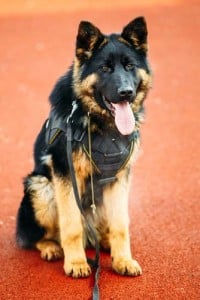 A lot of gear that is important to handlers of combat service dogs won’t be found on the dogs at all. Instead, these items are used in the training process. Perhaps the most recognizable piece of equipment is the “bite sleeve.”
A lot of gear that is important to handlers of combat service dogs won’t be found on the dogs at all. Instead, these items are used in the training process. Perhaps the most recognizable piece of equipment is the “bite sleeve.”
As the name implies, this item consists of padded arm protection that allows the dog’s trainer to be bitten, without being penetrated by the dog’s teeth. The same type of padded gear is available for other parts of the body as well. Even full suits of this thick material can be worn if the dog’s training requires attack on legs and torsos.
Although this article has covered an array of important service dog equipment, there are many more pieces of service dog gear that may be employed to help the dog and handler do their work, including:
- Muzzles
- Specialized collars
- Leashes
- Canine footwear
Other articles of clothing are often implemented as optional additions to the typical vests and harnesses as well. In the end, what a dog will use in the performance of its job will depend quite a bit on the preferences of the handler and the temperament of the animal. It will also depend on the job that the dog is required to perform.
READ NEXT: 5 Best Service Dog Vests and Harnesses for Working Dogs



